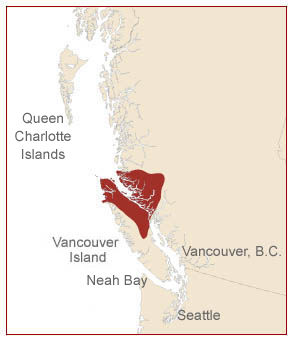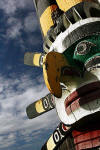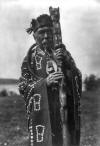AIS 100: Introduction to American Indian Studies
|
AIS 100: Introduction to American Indian Studies |
KWAKIUTL
Kwakiutl (Kwakwaka'wakw) are one of the
Wakashan language speakers that consisted of 17 or more tribes that lived on the
NE side of Vancouver Island and across Alert Bay mainland British Columbia,
Canada.  Kwakwaka'wakw
means those who speak the Kwak'wala language. These people consisted of
about 8 or more language groups of which 5 still exist. Some groups became
extinct or amalgamated with others
Kwakwaka'wakw
means those who speak the Kwak'wala language. These people consisted of
about 8 or more language groups of which 5 still exist. Some groups became
extinct or amalgamated with others
|
Language Group |
Area |
| Namgis | Nimpkish River |
| Kwakiutl | Ft. Rupert (Tsaxis) |
| Quatsino | Quatsino Sound |
| Kwicksutaineuk | Gilford Island |
| Tsawataineuk | Kingcome Inlet |
| Nakamgalisala | Hope Island |
| Awa'etlala | Knight Inlet |
| Yaltiaux | Cox and Lanz Islands |
I. Origins
The Kwakiutl (Kwakwaka'wakw) and Bella Bella are Wakashan language speakers who occupied the Northwest Coast as early as 8-10,000 years ago. Archaeologists argue still as to how much influence came from the Interior Plateau versus the Arctic North. Both may in fact be correct since the Wakashan language is distantly related to the Algonkian languages to the East yet artifacts (such as body armor, harpoons) and raven stories have connections to the Far North. Clearly, the maritime (sea adaptation) culture of the Northwest Coast became prevalent between 5,000 - 1,000 BC. The maritime features, including cedar boats, plank houses, deep sea fishing and whaling increased as people moved closer to coastal sites where rivers came into the sea.
II. Traditional Culture
The Kwakiutl (Kwakwaka'wakw) developed one of richest and most complex hunting and gathering cultures known to exist. With all the wealth provided by a temperate rainforest at the edge of the Pacific Ocean population density and social hierarchy mirrored what is normally seen with agrarian (farming) cultures. Only when European fur trade and diseases came in the mid 1800s did the coastal people begin to decline and their traditional culture change. Although reduced in number the people are still living in their original areas.
| Kwakiutl (Kwakwaka'wakw) <1850 | ||
| Language | Wakashan | Kwak'wala |
| Settlement | British Columbia, Canada | N, NE Vancouver Island , Alert Bay Islands and
 British Columbia Mainland
British Columbia Mainland |
| Economics (H&G) | Sea: candlefish, cod halibut River/Bay: salmon, eel shellfish, birds Beach/Forest: greens, berries, roots, cedar, deer, sheep, goat |
Summer H&G; spring candlefish, fall salmon runs
and game. Cedar wood: Planked houses (60-90'), totem poles, canoes (45'), boxes; cedar bark: textiles and cordage Bone, Stone (argillite), ivory, shell :tools, figurines, jewelry, money |
| Social | Family/Kinship: patrilineal or matrilineal/geographic clans Rank: Nobles (20%), Commoners (60%), Slaves (20%) Local/geographic groups: 30 groups exhibited by winter town with ruling noble/chief Ceremonial groups |
Bilateral kinship with vague totemic organization
based on family origins that bestowed crests and privileges. These were
assigned or inherited at the death of a family member, marriage or a
potlatch. The name implied privileges and crest and was called numaym.
privileges included the performance of songs or dances,
commissioning objects of art, display of crests, etc. Crests included
specific ancestral animals like eagle, thunderbird, killer whale, bear,
etc but also various powers such as 'river of wealth'. Screens, totem
poles, masks and a vast array of art objects depicted these crests and
powers.
 Ceremonial
groups were mainly secret societies of shaman, dancers, etc. Many of the
shaman had various powers to divine, diagnose, cure and put on spells. Ceremonial
groups were mainly secret societies of shaman, dancers, etc. Many of the
shaman had various powers to divine, diagnose, cure and put on spells. |
| World View | Myths: Transformer creates the world Cosmology: Basux profane time; T'seka sacred time Ritual : First Salmon (SP); Ancestors (Fall);Societies and Winter Ceremonials |
Winter Ceremonials: Dance Societies (Gwa'wina)
and Potlatch Potlatch: Most potlatches were giveaways held during the Winter ceremonials as celebration or declaration of rank derived from the acquisition or addition of privileges or crests. A potlatch included a distribution of goods or wealth. |
| Expressed Form | Songs and Dances Musical Instruments Totem poles, boxes and masks Shell, bone, metal jewelry |
Masks were the most important art object since
many depicted the mythical realm and origins of the animal/human
primordial beings and their power. The Hamatsa masks were the
most famous and stood for mythical beings the induction of novices that
are transformed by man-eating spirits, return as cannibals themselves
and are purified, thus transformed, into a normal person. |
II Contemporary Culture
The Kwakiutl went through many changes with various groups of Europeans exploring especially for fur bearing animals. There were approximately 8,000 Kwakiutl in 1830. In 1885 under pressure from government authorities and missionaries the potlatch was banned. The ceremonies went under ground and participants were arrested. Many works of art were stolen (confiscated) and placed in various museums. In 1951 the ban on potlatches was lifted, but it was not until 1988 that art objects including society masks were returned after much legal wrangling.
The Kwakiutl are one of the most extensively studied Native American groups most notably by Franz Boas (1858-1942) in 1890-1900. Boas had a primary informant that helped with language translations named George Hunt (1854-1933). Later, Helen Cordere, Ronald Rohner and Evelyn Bettauer reexamined Kwakiutl culture after WWII.
Today the Kwakiutl number about 4, 000 and live in about
15 bands in British Columbia. The potlatch has come back in recent years as
part of programs recovering language art and storytelling. The
U'mista Cultural Society is
non-profit corporation developed in 1972 to ensure the survival of traditional
culture and is located in Alert Bay, British Columbia, Canada.
| Contemporary Name | Area | Notes |
| Kwakiutl | Ft. Rupert, Vancouver Is. | |
| Kwiakah | S. Vancouver Is., Campbell River | |
| Kwa-wa-aineuk | Mainland, Hopetown | |
| Kwicksutaineuk | Gilford Island | |
| Mamalillikulla | Village Island | |
| Nimkish | Alert Bay, Vancouver Is. | |
| Nuwitti | N. Vancouver is. | |
| Quatsino | Western Vancouver Is., Quatsino Sound | |
| Campbell River | S. Vancouver Is., Discovery Passage | |
| Cape Mudge | Discovery Passage, Quadra Is. | |
| Comox | E. Vancouver Is | |
| Tanakteuk | Mainland, Knight Inlet | |
| Tlowitsis-Mumtagila | Vancouver Is. | |
| Tsawataineuk | Mainland, Kingcome Inlet | |
| Tsulquate | Mainland, Pt. Hardy |
Copyright © S. J. Crouthamel